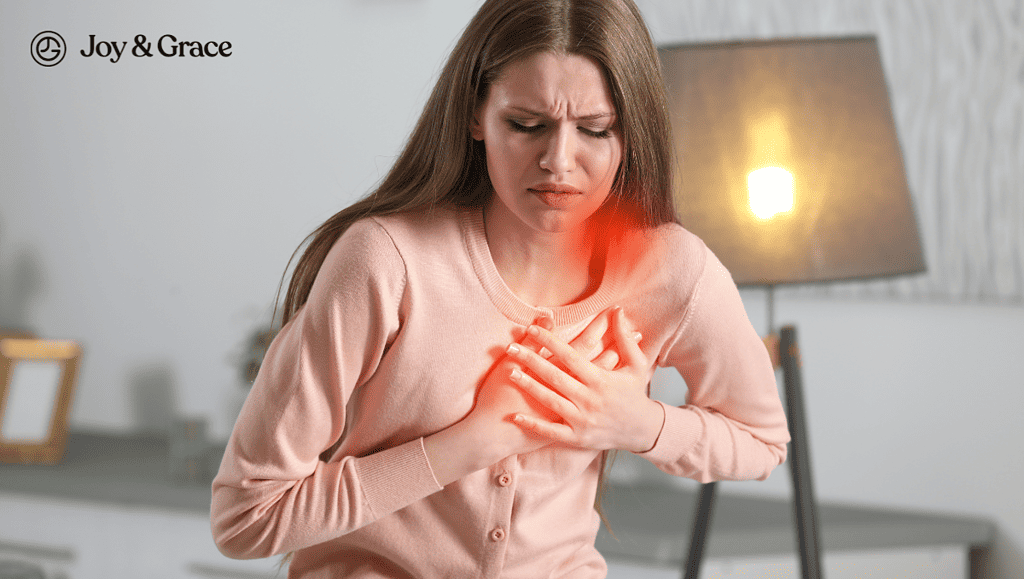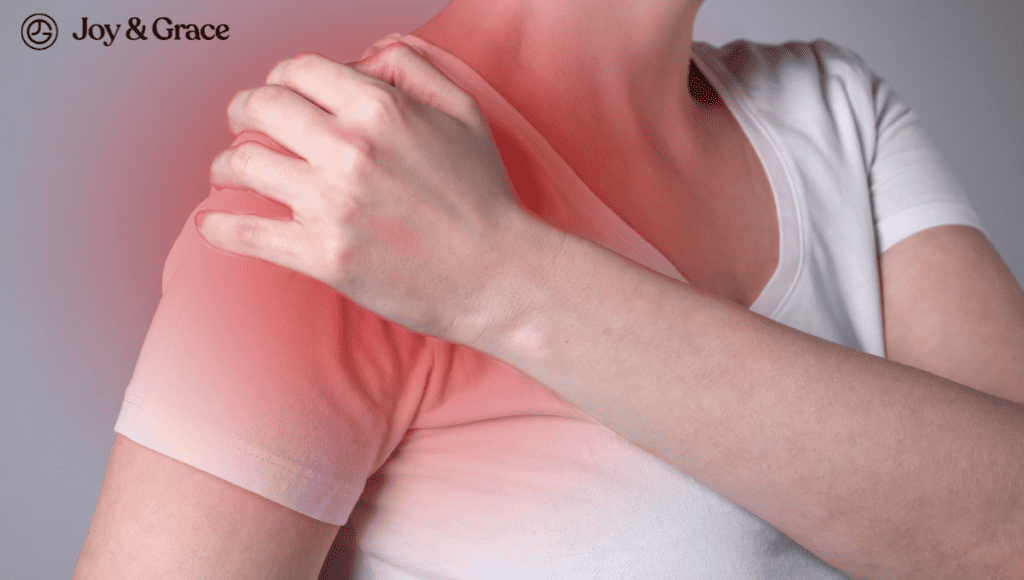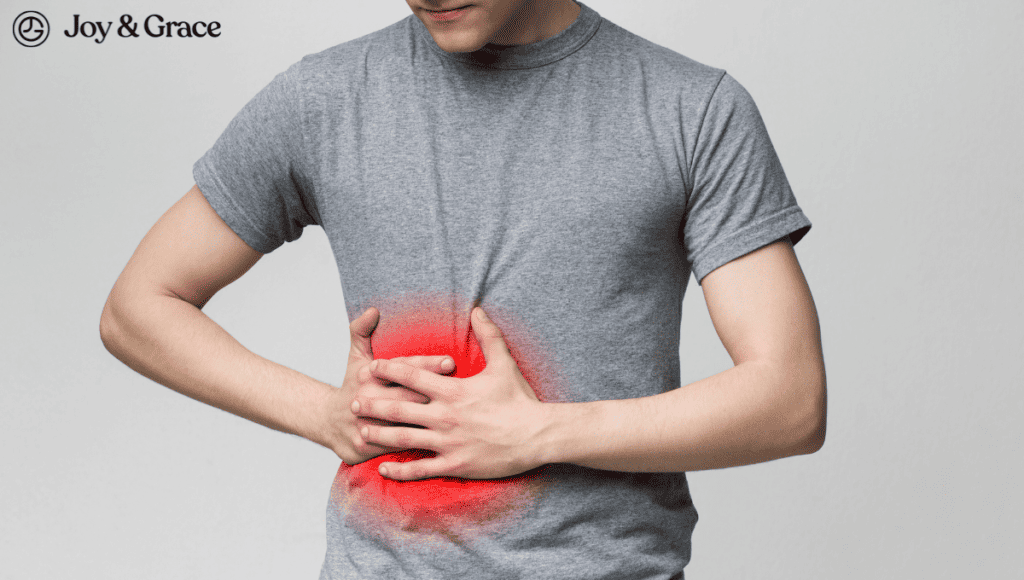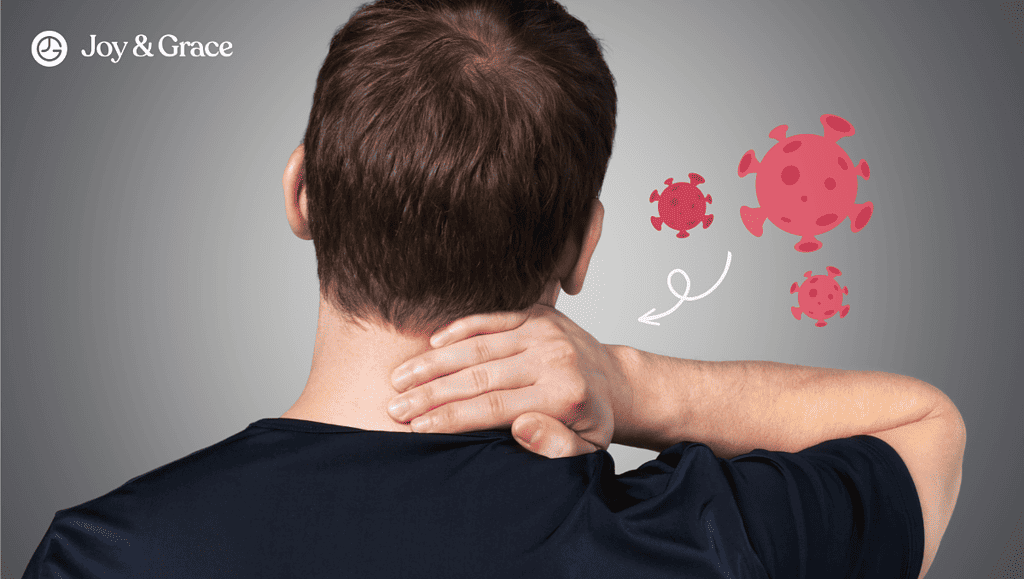Chest and neck pain on your left side can be alarming. These two symptoms can jolt you out of your daily routines with a worrisome "Why?". They can make you miserable day and night, disrupting peaceful moments. Instead of spending time worrying, let's spend some time understanding.
With a deeper knowledge of what may be causing your discomfort, you can speed up your path to relief. Whether you're in the middle of a yoga class or simply sipping tea on a Saturday morning, it’s time to address this discomfort. Read on and reclaim your cozy, pain-free existence.
Can Neck Pain And Chest Pain Be Related?

Yes, neck and chest pain can be related. The link between these two symptoms can be due to several connections, including:
- Muscular and Structural Connections
The muscles and structures of the neck are closely connected to those of the chest and upper back. Any injury in the neck area can lead to referred pain in the chest area and vice versa.
- Nerve Pathways
The nerves that originate in the neck also extend into the chest area. Irritation or compression of these nerves can result in pain that radiates to both areas.
- Breathing Patterns
Pain in the neck can affect breathing patterns, potentially causing discomfort or pain in the chest while breathing. Consequently, breathing problems can also cause or worsen neck pain.
Another concrete link between neck pain and chest pain is “Cervical Angina.” These two words are a combination of “cervical,” which means neck, and “angina pectoris,” which translates to “the choking of the chest.”
Let’s review cervical angina first.
Can Cervical Angina Cause Left-Side Chest And Neck Pain?

Depending on the structures, or the side affected, cervical angina can cause pain in your left chest and neck.
Cervical angina is a type of chest discomfort or pain originating from the neck area (cervical spine).
It is also known as "pseudo-angina" or "cervical chest pain." It feels similar to the chest pain associated with heart-related issues. However, in cervical angina, the pain is not caused by problems in the heart or coronary arteries.
Cervical angina is usually accompanied by:
- Neck pain
- Arm pain
- Tenderness around your breastbone
- Fatigue
- Tingling, numbness, or weakness that travels down the arm
- Headaches
This condition is somewhat controversial and not fully understood. However, according to researchers, cervical angina can result from the following:
Cervical Nerve Root Compression:
A common explanation has been that the pain is caused by pressure on the nerves in the neck (cervical nerve roots). Some nerves from the neck also control muscles in the chest. When these nerves are compressed, they might cause diffuse pain that spreads to the end of the nerve. This can be felt as pain in your chest.
Cervical Sympathetic Nerves:
The pain might also be caused by nerves from the neck that also supply the heart and blood vessels.
These nerves are believed to be a chain of sympathetic nerves in the neck near the carotid artery.
In the past, it was suggested that issues with these sympathetic nerves could lead to discomfort in the chest area.
Referred Pain and Other Factors
Sometimes, the pain might be felt in one area of the body, even if the problem is elsewhere. This is called referred pain. Even if nerve root compression isn't causing the pain, other issues could lead to referred pain. These can include:
- Degeneration of cervical disks
- Problems with the joints between your vertebrae
- Problems with the ligaments in your neck
There's a nerve called the sinuvertebral nerve that might transmit this kind of referred pain.
Spinal Cord and Other Possibilities
Problems in the spinal cord might also lead to angina-like pain.
These include:
- Tumors in the spinal cord
- Myelopathies
- Lack of blood flow to the spinal cord (spinal cord infarction)
Please note, however, that these are relatively rare causes of such pain.
Why Does The Left Side Of My Chest And Neck Hurt?
Aside from cervical angina (which we mentioned earlier), the pain in the left side of your chest and neck may also be due to several causes.
The most likely cause is musculoskeletal issues.
Strained muscles or ligaments, often caused by overuse or poor posture, could lead to discomfort that radiates from the chest to the neck.
Aside from these relatively mild causes, certain conditions (described just below) affecting your musculoskeletal system can also cause left-sided chest and neck pain.
Another potential cause of left-sided chest and neck pain could be related to the heart. Angina, which is chest pain or discomfort caused by reduced blood flow to the heart muscle, might radiate to the neck and left arm.
Digestive issues may also cause pain in your left chest and neck due to referred pain.
Lastly, lung problems may also be the cause of your discomfort. Any inflammation or injury to the lungs can cause chest pain, which may also travel to your neck.
Musculoskeletal And Nerve-Related Causes Of Left-Sided Chest And Neck Pain
Cervical angina
As mentioned earlier, cervical angina is a type of chest pain that is due to problems in the neck. Conditions that can cause cervical angina also cause neck pain, and these include:
Compression or irritation of a nerve root on the left side of the cervical spine can lead to sharp or shooting left-sided neck pain. The pain can travel down the left arm and may be felt on the left side of the chest.
- Cervical Herniated Disc
A herniated disc in the left side of the neck can impinge on nerves. Like cervical radiculopathy, it can cause neck pain that radiates down the left arm. The pain may also be felt as left-sided chest pain.
Degeneration of the left side cervical spine joints can lead to neck pain that may radiate to the left side of the chest due to referred pain.
- Cervical Fracture
A fracture on the left side of the cervical vertebrae can cause severe neck pain and muscle spasms that can radiate to the left chest.
Broken or dislocated rib
Accidents can cause the ribs protecting your chest to break or move out of place. A broken rib on the left side can result in sharp, localized left-sided chest pain. A broken or dislocated rib can also cause neck pain.
Sprained chest and neck muscles
Injuries to the muscles on the left side of the chest and neck can create tears. These tears can lead to left-sided chest pain, particularly when you move.
Strained chest and neck muscles
Overuse or improper use of the muscles on the left side of the neck can lead to strains or muscle spasms, causing localized left-sided neck pain that may radiate to the chest area.
Costochondritis
Inflammation of the cartilage that connects the left rib to the breastbone can cause left-sided chest pain that may extend to the left side of the neck. The pain is often sharp and can be exacerbated by movement or deep breathing.
Thoracic Outlet Syndrome
This condition occurs when nerves or blood vessels are compressed between the collarbone and the first rib. If this happens on the left side, it can lead to pain in the neck and left side of the chest. It can also affect the shoulder.
Muscle Imbalance
Poor posture, muscle imbalances, or weak muscles on the left side of the chest and neck area can lead to strain and discomfort, potentially causing left-sided chest and neck pain.
Myofascial Pain Syndrome
Trigger points or knots in the muscles on the left side of the neck and chest can cause localized left-sided pain that may be felt in the left side of the chest area.
Trauma
Direct trauma to the muscles on the left side of the chest or neck can cause bruising, swelling, and pain.
Respiratory Causes Of Pain In The Left Side Of The Neck And Chest
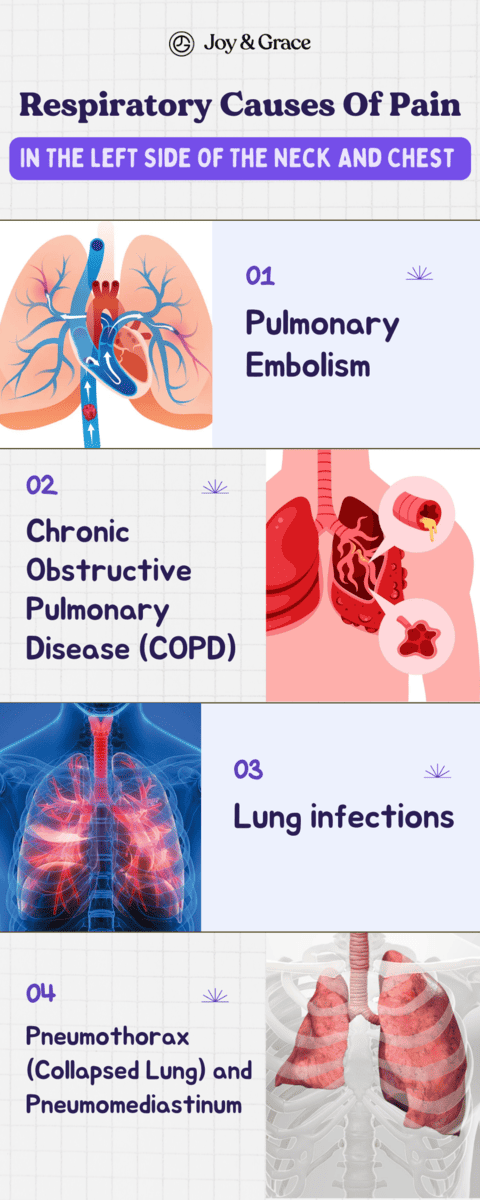
The following lung-related issues can also contribute to left-side chest and neck pain:
- Pulmonary Embolism
A blood clot obstructing a pulmonary artery can lead to sharp pain under your breastbone or one side of your chest. The pain usually intensifies during breathing. Shortness of breath is often a concurrent symptom. According to a case report, pain can also be referred to the neck and shoulder.
- Chronic Obstructive Pulmonary Disease (COPD)
COPD is a lung condition that makes breathing difficult due to narrowed airways and damaged lung tissue. It’s typically caused by smoking or long-term exposure to irritants. Damage to air sacs and airway linings can also cause tightness in the chest.
No studies suggest COPD can cause pain on one side of the chest. However, according to a study, chest pain was more common and severe in COPD patients. Other common locations of pain include the neck, shoulder blades, and lower back.
- Lung infections
Lung infections, such as pneumonia, can result in chest pain on either side. This may be due to pleurisy or the inflammation of the lining of the lungs. Fever, chills, and a productive cough often accompany the pain. Pain from pneumonia can also spread to the neck and shoulders.
- Pneumothorax (Collapsed Lung) and Pneumomediastinum
The presence of air between lung layers can lead to sudden, sharp chest pain, potentially radiating to the neck and shoulder.
Heart-Related Causes Of Left-Sided Chest Pain And Neck Pain
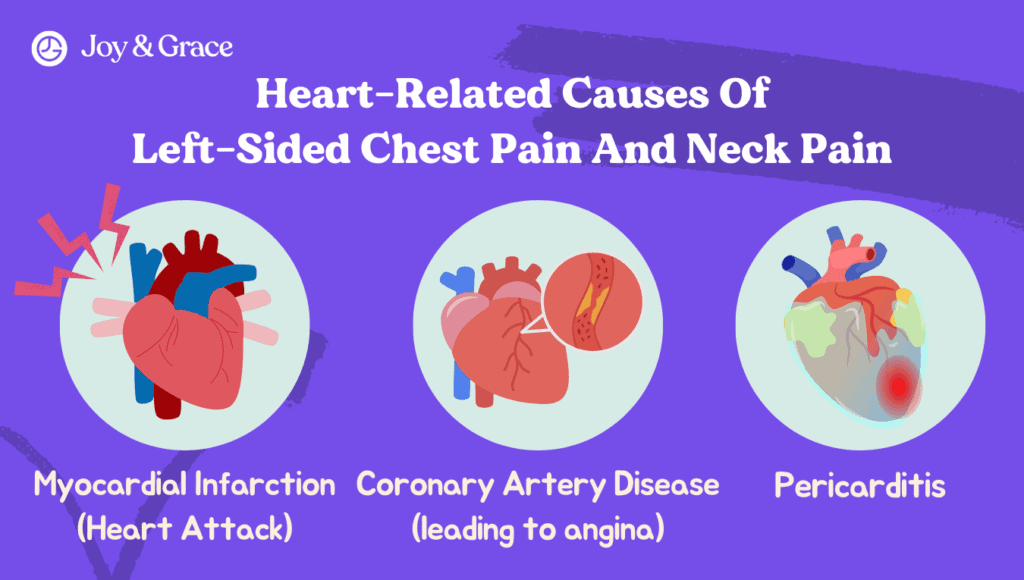
Left-sided chest pain can be associated with heart-related issues. Your heart is located slightly left of the center of the chest. Any problems with the heart can cause discomfort radiating to the left side of the body. This potentially includes the left side of the neck or even the left arm.
In most cases, this pain is due to angina. Angina occurs when the heart muscle doesn't get as much blood as it needs. This situation arises when one or more heart arteries are narrowed or blocked.
Hence, when left-sided chest and neck pain arises, it's important to consider potential heart and vascular issues. These can include conditions like:
- Myocardial Infarction (Heart Attack)
A heart attack occurs when a blockage in a coronary artery restricts the oxygen-rich flow of blood to the heart muscle. The result is a distressing sensation of pain or pressure radiating across the chest.
Chest pain is often a prominent feature of a heart attack. The pain can also travel to the left neck, arm, or shoulder. These are usually accompanied by:- Back or jaw pain
- Shortness of breath
- Fatigue
- Dizziness
- Sweating
- Nausea
- Coronary Artery Disease (leading to angina)
Accumulated cholesterol can narrow and obstruct blood vessels supplying the heart with blood. This condition can lead to increased discomfort during physical exertion (angina). This is because the heart muscle struggles to receive an adequate blood supply.
- Pericarditis
Inflammation of the heart's lining can provoke sharp chest pain. This discomfort may extend to your neck, left shoulder, and arm. The pain may be worse when lying down or taking deep breaths.
Digestive-Related Causes Of Left-Sided Chest Pain And Neck Pain
Certain digestive conditions can also manifest as left-side chest pain that can radiate to the neck:
- Gastroesophageal Reflux Disease (GERD)
Acid reflux from the stomach into the esophagus can cause a burning sensation in the middle of your chest. You can feel it on your chest's left and right sides, too. The pain from GERD can also travel to the neck.
How Can I Tell Between The Cardiac And Non-Cardiac Causes Of Left Chest And Neck Pain?

Experiencing left-side chest and neck pain can be concerning, given its association with potentially serious conditions like heart disease. But not every incident of these symptoms indicates a heart problem. Let's hash out the differences between cardiac and non-cardiac chest and neck pain to help you discern one from the other.
When distinguishing between cardiac and non-cardiac causes of left chest and neck pain, it's important to consider certain factors.
Cardiac causes often involve the heart and its blood vessels. You might notice a squeezing or pressure-like sensation in the chest that may radiate to the left arm, neck, or jaw. You may also exhibit Levine’s sign (holding a clenched fist over your chest).
The pain could be triggered by physical activity or emotional stress and ease with rest. Furthermore, the pain can be accompanied by:
- Shortness of breath
- Sweating (sometimes described as a "cold sweat")
- Nausea
- A feeling of impending doom
If these symptoms occur, seek help immediately. They could signal emergency medical conditions like a heart attack or unstable angina.
Non-cardiac causes, on the other hand, might involve muscles, bones, or other organs.
The pain might be felt as more of a sharp and stabbing one, or localized to one area. The pain could worsen when moving or pressing on the area. It may be related to muscle strain, inflammation, or even acid reflux. Sometimes, the pain could be linked to anxiety (such as in panic attacks) or other non-heart-related conditions.
Still, it's important not to jump to conclusions. Cardiac and non-cardiac causes can sometimes have overlapping symptoms. If you're ever uncertain about the cause of your chest and neck pain, it's always wise to seek medical evaluation.
Remember, while these general descriptions can provide some insights, only a healthcare professional can make definitive diagnoses.
What Are Common Symptoms Associated With Left Chest And Neck Pain?
Depending on the specific cause, the following may accompany the pain in your left chest and neck:
- Shortness of breath
- Sweating
- Nausea or vomiting
- Lightheadedness or dizziness.
- Heartburn or acid reflux
- Pain worsened by deep breaths or certain movements
- Burning sensation in the chest or throat
- Rapid or irregular heartbeat
- Feeling of impending doom.
- Tearing or ripping sensation in the chest or neck
- Popping or clicking noises
- Numbness or tingling
- Weakness of the arms and hands
- Swelling
- Tenderness
- Cough
What Should I Do For Left Chest Pain And Neck Pain?

If you're suffering from left-sided chest and neck pain due to muscle strain, here are some steps you could consider:
- Rest and relaxation
If the pain is mild and doesn't seem to be related to a serious condition, consider resting and practicing relaxation techniques. Stress and tension can contribute to neck and chest discomfort.
- OTC Pain Relievers
Over-the-counter (OTC) pain relievers like ibuprofen or acetaminophen might help alleviate mild pain. However, it's important to follow the recommended dosages and guidelines.
- Heat or Cold Therapy
Applying a heat pack or cold compress to the affected area may help reduce muscle tension and ease discomfort. Some people find heat more effective for muscle-related pain, while others prefer cold for inflammation.
- Proper posture and ergonomics
Poor posture can contribute to neck and chest pain. Pay attention to your posture while sitting, standing, and working. Ensure your workspace is ergonomically designed to reduce strain on your neck and back.
- Gentle stretching
Gentle neck and shoulder stretches may help relieve tension and improve flexibility. Consult a healthcare provider or physical therapist for appropriate stretches.
- Hydration and nutrition
Ensure you're staying adequately hydrated and maintaining a balanced diet. Dehydration and certain nutrient deficiencies can contribute to muscle cramps and discomfort.
- Avoid heavy lifting
If the pain is related to muscle strain, avoid lifting heavy objects or engaging in activities that could exacerbate the pain.
- Mind-body techniques
Techniques like deep breathing, meditation, and yoga may help reduce stress and alleviate pain. Consult a professional if you're unfamiliar with these practices.
Remember, these are just some simple ways to relieve pain from mild causes. Nothing beats talking to a healthcare professional for an accurate diagnosis and proper medical treatment.
When Should I Worry About Neck And Left Chest Pain?

If you are experiencing neck and chest pain, it's important to consider the context and severity of the pain. While mild discomfort can sometimes be attributed to factors like muscle strain, there are instances where you should seek medical attention promptly:
Sudden and Severe Pain
If your neck and chest pain is sudden and intense, it could be a sign of a serious condition, such as a heart attack.
Duration of Pain
Seek medical attention if your pain persists for an extended period. Chronic or recurring pain could indicate an underlying issue.
However, pain that lasts for more than a few minutes or comes and goes over a period of time may also require medical attention. This depends on the cause and other symptoms.
Associated Symptoms
Pay attention to any other symptoms that accompany the pain. These may include:
- Difficulty breathing
- Sweating
- Nausea
- Vomiting
- Dizziness
- Fainting
These symptoms could indicate a heart condition or other serious issues.
Pain Trigger
If the pain is triggered by physical activity or stress, it might indicate angina or other heart-related problems.
Previous Medical History
Don’t underestimate your pain, and consult a medical professional if you have a history of the following:
- Heart disease
- High blood pressure
- Diabetes
- Other cardiovascular issues
- Lung problems
Age and Risk Factors
Certain risk factors can increase your likelihood of heart-related problems. These include:
- Being older
- Having a family history of heart disease
- Smoking
- Obesity
- Sedentary lifestyle
If you fall into these categories, you should be vigilant about any unusual symptoms.
Other Causes
If you suspect respiratory and digestive issues might be contributing to your pain, it's a good idea to consult a healthcare provider.
Remember, it's always better to err on the side of caution regarding chest and neck pain. If you are ever in doubt or have severe symptoms, it's important to seek immediate medical attention. Only a qualified medical professional can accurately diagnose and treat your condition.
Takeaway
Experiencing left-sided chest and neck pain can be concerning. It disrupts your daily life and raises worries about potential causes. Understanding the possible reasons behind this discomfort can help you take steps towards relief and peace of mind.
Neck and left-sided chest pain can occur together due to various bodily connections. And these connections can come into play whether your pain is caused by:
- Musculoskeletal issues
- Respiratory issues
- Heart problems
- Digestive issues
Of the various reasons, cardiac causes may be the most worrisome. Distinguishing between cardiac and non-cardiac causes is important, as symptoms may overlap. Some simple strategies might offer relief if the pain is mild and potentially due to muscle strain.
However, sudden and severe chest pain with accompanying symptoms should prompt immediate medical attention. Always prioritize your health and consult a healthcare professional for proper medical advice.
